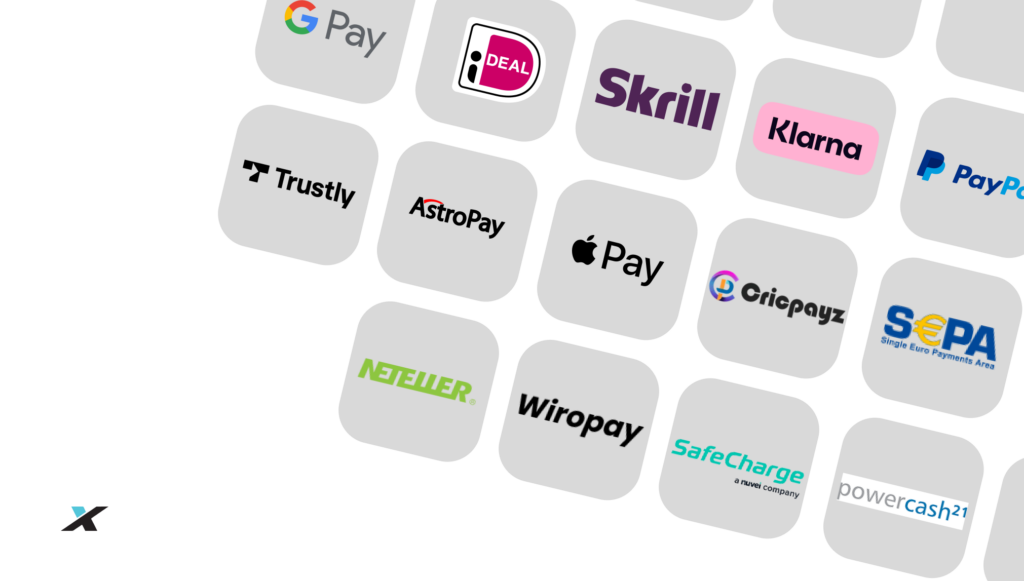How to Choose the Best Alternative Payment Method for Your Business

Giving consumers only credit or debit cards as a choice for a deposit is now a huge no-no. Although debit and credit cards are still somewhat common, APMs are becoming rather popular. These techniques provide customers and companies more freedom, convenience, and usually reduced prices. An overview of APMs is provided in this guide along with explanations of what they are, the many possibilities that are accessible and the advantages for your brokerage.
What are Alternative Payment Methods (APMs)?
Any payment other than a conventional credit or debit card—that is, Visa, Mastercard, American Express, or Discover—is known as an alternative payment method (APMs). They represent a diverse and growing range of payment options, tailored to specific regions, industries, or customer preferences. APMs leverage various technologies and networks, including bank transfers, digital wallets, mobile payment systems, prepaid cards, and even cryptocurrencies. If it’s a way to pay that doesn’t involve swiping or inserting a traditional card, it’s most likely an APM.
PSPs vs. APMs: What’s the Difference?
They are both important parts of online payments, but they do different things.
As a go-between for merchants, customers, and payment networks, a PSP is a business that helps people make electronic purchases. They are in charge of the technical side of making deals.
That being said, APMs are the exact ways that customers pay other than with cards. A PSP might accept a lot of different APMs, which lets businesses give their customers a choice of how to pay.
Picture an APM as the “highway” and a PSP as the “vehicles” that go on it.
Types of Alternative Payment Methods
No one knows how many APMs exist but new options appear constantly. Let’s go through the major categories.
Bank Transfers – Payments made directly from a customer’s bank account to a merchant’s account.
Examples: ACH transfers (US), SEPA transfers (Europe), Faster Payments (UK), EFT (Canada)
Digital Wallets (eWallets): Online accounts that store payment information and allow users to make purchases without entering their card details for each transaction.
Examples: PayPal, Apple Pay, Google Pay, Amazon Pay, Alipay, WeChat Pay
Mobile Payments: Payments made using a mobile device, often linked to a digital wallet or bank account.
Examples: Often overlap with digital wallets (Apple Pay, Google Pay), but can also include carrier billing (paying through your mobile phone bill).
Prepaid Cards: Cards loaded with a specific amount of money that can be used for purchases.
Examples: Paysafecard, gift cards from specific retailers.
Buy Now, Pay Later (BNPL): Services that allow customers to pay for purchases in instalments, often interest-free.
Examples: Klarna, Afterpay, Affirm
Cryptocurrencies: Digital or virtual currencies that use cryptography for security.
Examples: Bitcoin, Ethereum

What are the benefits of Accepting Alternative Payment Methods?
From increased sales to reduced costs offering APMs can provide significant advantages for businesses – let’s take them one by one.
Increased Sales and Conversion Rates
You can get customers who might not have or prefer not to use traditional credit or debit cards. This is especially important for reaching younger demographics and international customers.
Lower Deposit Abandonment
Offering familiar and preferred payment options reduces friction at checkout, leading to fewer abandoned carts and more completed transactions.
Lower Transaction Fees (Potentially)
Some APMs, particularly bank transfers and certain digital wallets, have lower processing fees compared to credit cards. This can result in significant cost savings, especially for brokers with high transaction volumes.
Improved Customer Satisfaction
Giving choices and convenience improves the client experience, increasing brand loyalty.
Access to New Markets
APMs can open up access to new markets, particularly in regions where credit card penetration is low or where specific APMs are dominant.
Reduced Fraud and Chargebacks (Potentially)
Some APMs, like certain digital wallets, have built-in security features that can reduce the risk of fraud and chargebacks.
Faster Settlement Times (Potentially)
Some APMs offer faster settlement times compared to traditional card payments, improving cash flow.
How to Choose the Best Alternative Payment Method for Your Business
Selecting the right mix of APMs requires careful consideration of your target audience, industry, geographic location, and business model.
Step 1 – Understand your target audience
Consider the demographics of your typical customers. What are their ages, locations, and income levels? This information will significantly influence their payment preferences. Are your customers tech-savvy and comfortable using digital wallets and mobile payments, or do they prefer more traditional methods like bank transfers?
Geographic location plays an important role, too. Are there specific APMs that are particularly popular or widely used in your target markets? Researching regional payment trends to make sure you are picking the correct ones.
Step 2 – Analyze your industry
What payment methods do your competitors offer? Keeping an eye on the competition can give you valuable insights into industry standards and customer expectations. Are there any APMs that are commonly used within your specific industry sector?
Step 3 – Consider your business model
Think about your typical transaction value. Do you mostly process high-value or low-value transactions? This can influence the suitability of certain APMs, as some may have transaction limits or fee structures better suited to specific transaction sizes.
Consider your transaction volume as well. Do you have a high or low volume of transactions? High-volume businesses may be able to negotiate better rates with some APM providers. Finally, your model matters. Do you have a subscription model, or one time payments?
Step 4 – Evaluate costs and fees
Carefully compare the transaction fees associated with different APMs. These fees can vary significantly, so it’s essential to understand the cost implications of each option. Investigate if there any one-time setup fees associated with integrating a particular APM. Also check for any recurring monthly fees for using the APM service.
Step 5 – Technical integration
Assess the ease of integration. How easily can the APM be integrated with your existing platform or payment gateway? To simplify the process, look for APM providers that offer well-documented APIs and SDKs.
Step 6 – Security and compliance
Does the APM offer security measures to protect against fraudulent transactions? Ensure the APM provider complies with all relevant data security standards and regulations.
Integrating APMs
While there are some particular differences, integrating APMs calls for similar considerations to integrating PSPs:
- Many PSPs already support a wide range of APMs. Choosing a PSP that supports the APMs you need can simplify the integration process.
- Some APMs may require direct integration with your platform, bypassing a PSP. This can offer better control even if a bit more complex.
- Ensure that the APM integration provides a user-friendly experience for your customers.
- Test the APM integration thoroughly before going live to ensure that it works correctly and securely.
- Be aware of any regional regulations or legal requirements related to specific APMs.
Although thorough pre-built integrations provide great value, you should also consider the ability to integrate new APMs. A solution that allows relatively easy integration of additional payment methods can provide a long-term advantage.
Our company provides a proprietary cashier system that features more than 70 integrated Alternative Payment Methods (APMs), and we keep adding more as our clients expand into new markets. Curious to see if we already have the one you need? Book a demo and we’ll be happy to share the list.
Conclusion
Are you offering the payment methods your customers want? Alternative Payment Methods (APMs) are no longer optional – they’re a vital part of a modern payment strategy.
Offering the right mix of APMs can help you reach more customers, improve satisfaction, and potentially lower costs. We hope this article helped you to carefully consider your options and choose the payment methods that best fit your business needs.






